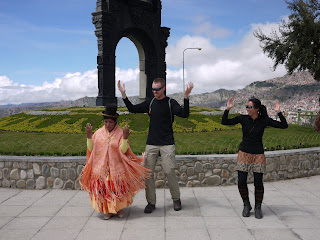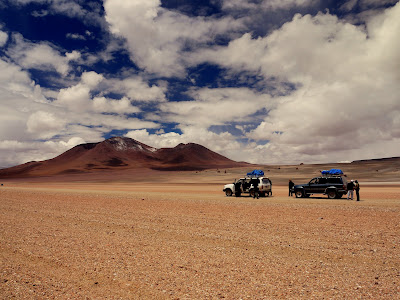Puerto Madryn and Rio Gallegos
We left El Chalten to start heading north again, but we had to go to Rio Gallegos first as that's the central bus hub of the south. Rio Gallegos is kind of a rough town, not very touristy. We read about a large penguin colony 150km south of RG, but after asking around town where it was and how to get there, it was clear that nobody went there and if we wanted to do it then the best way would be to rent a car. So after asking a few fellow travellers if they wanted to join us, we also learned that nobody else gave themselves a day to spend in RG, they all just got off a bus, and spent only the time until the next bus, no more.
So we went and rented a car and got our first taste of S American driving. Although it was pretty tame, as we had to drive through only about 20 blocks of the town before hitting the highway (15km of pavement, followed by 135km of dirt) and cruising down to the penguin reserve. Upon arriving, the info center looked deserted and we were worried that maybe there wouldn’t be any penguins. But then we looked down the road towards the coast and saw some just chillin’ like villains on the side of the road. So we drove slowly down the road and hung with them for a bit, only to head into the main area and see NO other people for 2 hours, only a good portion of the estimated 120,000 penguins that live there.... Unfortunately we missed the hatching season, which is in Dec I think, and hence we were treated to the adolescent crowd... was I that ugly when I was a teenager? They were definitely hanging in their respective posies, some with all the cool kids, some that looked kind of nerdy and some that looked like their mom just pulled them away from their Nintendo.
We hung out with the penguins for a couple of hours, watching them waddle down their pathways, hang out under bushes to escape the wind, followed by watching them sunbathe like a bunch of tourists on a beach, and we could also see them swimming in the rough waves just offshore. I think they swim faster than the rental car drove down the dirt road! We really enjoyed this portion of the trip, one of the highlights for sure, as it was nice to get off the beaten track and do our own thing. We would definitely recommend this trip to anyone!
Then it was off to Puerto Madryn, where we were treated to many tourists hanging out on the beach. The first day we took it easy, but day number 2 we went to an elephant seal viewing area. We took a guided tour, with only the guide and us, to a small gravel beach surrounded by 100m cliffs. The guide showed us how approach the seals safely without getting them too worried about how close we were getting.... so we kind of shimmied across the gravel on our backs, in a way imitating their movements, and got to about 2-3m away from these awesome animals. It was kind of nerve-wracking, but at the same time, we didn’t really feel like we were in any danger. However, once again, we were looking at the adolescent crowd and not the HUGE adult males, which can grow to 5m in length and something ridiculous in weight.... like 2 tonnes or something. Can’t remember. We learned about the hunting practices of the elephant seal, and about how males typically hold their breath for 90 minutes and can dive to 1500m!!! Down that far, they catch their main source of food, squid. I’m not sure how they manage to see the squid down that far, as there would be very little light, but perhaps that explains their golf-ball-sized eyes.... kind of like a large aperature camera lens I suppose....
The next day we rented bikes and headed for a sea lion colony 15km from town. The woman at the hostel told us that it was a gravel path and people bike there often... so in my head I’m thinking crushed rock pathway, fairly smooth, no cars... maybe some nice shrubs or small trees on either side (even though we were a stones throw from the ocean, we were in a desert, so I was not expecting large trees). So off we go, with our crappy rental bikes.... only to find that the road is a sand road, shared by many cars, trucks, buses, you name it, all throwing dust in the air. The road was very rough and impossible to bike fast without being shaken to pieces... but at least it was also too rough for the vehicles to drive very quickly, so that was good in a way... trying to look at the bright side.
The sea lion colony was kind of anti-climatic, because we viewed them from about 100m away, and because we were only 2-3m from the elephant seals the day before, it seemed more like we were in a zoo than watching wild animals. The heat was getting to us, so we headed back for the rest of the bum-shaking bike ride. At least we had a tail wind pushing us home.
The final day in Puerto Madryn was spent going to the Peninsula Valdes. One of the largest ecological reserves of this type (as it turns out, of-this-type means “ocean”) in Argentina. We were delighted to watch all the sheep, cows and horses grazing 100m away from the coast, especially considering that the guide 2 days prior told us that it takes about 20 years for the vegetation to recover after the ranchers let the sheep graze the land, because the sheep dig at the plants with their hoofs and actually pull most of the roots out. You can probably guess that this isn’t exactly good for a plant living in the desert. It made us feel guilty about eating lamb and supporting this type of activity.....
Anyway, we got to see more penguins and sea lions, and thankfully, we got to see some orcas (killer whales) hunting just off the coast, patrolling for sea lions. Some orcas in this region feed by intentionally beaching themselves, so they can catch a sea lion pup on shore. It was too bad that we weren’t able to witness this incredible phenomenon.
Then it was back to reality, and preparing for another long bus journey.... this time onto Chile.





























